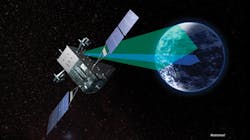KIRTLAND AIR FORCE BASE, N.M. - Electro- optical sensors designers at Raytheon Co., are pushing the state of the art in radiation-hardened infrared focal plane array space sensors for the most demanding strategic space applications.
Officials of the U.S. Air Force Research Laboratory at Kirtland Air Force Base, N.M., have announced a $7.4 million completion form contract to the Raytheon Vision Systems segment in Goleta, Calif., for the Focused Opportunity Reaching Toward Reliable Electro-Optic Strategic Sensors (FORTRESS) program.
Raytheon engineers will design, grow, and fabricate large-format mercury cadmium telluride infrared focal plane array detectors with ultra-low noise and high quantum efficiency. These devices must be able to survive bombardment by space radiation, as well as laser attacks.
The work is part of the Air Force FORTRESS effort to advance and maintain the state-of-the-art, scientific knowledge, growth, processing, and characterization capability in low-noise infrared sensor chip assemblies (SCAs) for national strategic space applications, such as electro-optical surveillance satellites.
Raytheon experts are fabricating infrared sensor chip assemblies that are at least as large as six centimeters on a side with pixel pitch of 18 microns. Supervising the program are officials of the advanced electro-optical space sensor program of the Air Force Research Lab's Space Vehicles Directorate.
These space infrared sensors must be able to resist any ill effects of 100 kilorads total-dose ionizing radiation without any single-effect upsets, and must be able to withstand charged particles of 63 MeV to a proton fluence of 7.43 x 1011 protons per square centimeter.
While these specifications represent a minimum requirement, Air Force researchers say they expect Raytheon to be able to design space sensors that will far exceed requirements. FORTRESS sensor chip assemblies are expected to operate with minimally degraded performance in a space environment where protons, electrons, heavy-ions all are present.
In addition, researchers would like these sensor chip assemblies to be immune to performance degradation when exposed to laser radiation; the read-out integrated circuit must be intrinsically hardened to prevent performance degradation when subjected to high irradiance light.
On this contract, Raytheon will do the work in Goleta, Calif., and should be finished by July 2019.
FOR MORE INFORMATION visit Raytheon Vision Systems online at www.raytheon.com, and the Air Force Research Lab Space Vehicles Directorate at www.kirtland.af.mil/Units/AFRL-Space-Vehicles-Directorate.

